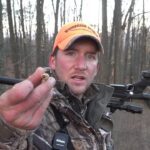Best dog to track wounded deer – For hunters, finding a skilled dog to track wounded deer is crucial. These canine companions possess exceptional abilities that assist in the successful recovery of game. In this comprehensive guide, we’ll explore the best dog breeds for tracking wounded deer, their training methods, essential gear, and captivating case studies.
From the legendary Bloodhound to the tenacious German Shepherd, discover the ideal canine partner for your hunting adventures. Join us as we delve into the fascinating world of tracking wounded deer with the best dogs by your side.
Introduction

Tracking wounded deer is an essential part of hunting, as it allows hunters to recover their game and ensure a clean kill. An ideal tracking dog is one that is able to follow a deer’s scent trail, even over long distances and in difficult terrain.
There are several characteristics that make a good tracking dog. These include:
Tracking Ability
- A strong sense of smell is essential for a tracking dog. The dog must be able to pick up on even the faintest scent trail and follow it.
- A good tracking dog will also have the stamina and endurance to follow a deer for long distances, even in difficult terrain.
- The dog must be able to work independently, but also be obedient to its handler.
Breeds Suited for Tracking Wounded Deer

When it comes to tracking wounded deer, certain dog breeds excel due to their keen senses, trainability, and unwavering determination. Here’s a table outlining some of the most suitable breeds for this demanding task:
| Breed | Size | Temperament | Tracking Ability |
|---|---|---|---|
| Bloodhound | Large | Gentle, affectionate, stubborn | Exceptional tracking ability, renowned for their acute sense of smell |
| German Shepherd | Medium to Large | Intelligent, loyal, protective | Highly trainable, excellent tracking skills, and a strong prey drive |
| Beagle | Small to Medium | Friendly, curious, determined | Good tracking ability, especially in dense undergrowth, known for their vocal persistence |
| Coonhound | Medium to Large | Independent, vocal, persistent | Excellent tracking skills, specifically for raccoons and other nocturnal animals, but also effective for deer tracking |
| Dachshund | Small | Independent, courageous, loyal | Surprisingly good tracking ability for their size, particularly in rough terrain and dense vegetation |
These breeds possess specific traits that make them ideal for tracking wounded deer. Bloodhounds, with their unparalleled sense of smell, can follow a scent trail for miles. German Shepherds are highly intelligent and trainable, making them versatile and reliable tracking partners.
Beagles, despite their smaller size, are known for their determination and vocal persistence, making them effective in dense undergrowth. Coonhounds are specifically bred for tracking nocturnal animals, including deer, while Dachshunds, with their low stature and independent nature, can navigate challenging terrain and dense vegetation with ease.
Training and Techniques: Best Dog To Track Wounded Deer
Training a tracking dog requires patience, consistency, and positive reinforcement. The basic principles involve:
- Establishing a strong bond with the dog and building trust
- Teaching the dog to follow a specific scent
- Rewarding the dog for successful tracking
Methods for Tracking Wounded Deer, Best dog to track wounded deer
Various methods can be used for tracking wounded deer with a dog, including:
Trailing
The dog follows the scent of the deer’s blood trail.
Air scenting
The dog uses its sense of smell to detect the deer’s scent in the air.
Trailing and air scenting
A combination of both methods, where the dog follows the blood trail and uses air scenting to locate the deer.
Step-by-Step Guide to Training a Tracking Dog
The ideal dog for tracking wounded deer possesses an acute sense of smell and unwavering determination. While the Black and Tan Coonhound excels in this role, other breeds like the Plott Hound and Bloodhound are also highly capable. Interestingly, the fallow deer is a species known for its adaptability and has even been domesticated as pets.
However, when it comes to tracking wounded deer, the unwavering focus and keen nose of a well-trained hunting dog remain indispensable.
1. Start with Basic Obedience
Ensure your dog has a solid foundation in basic obedience commands before beginning tracking training.
2. Introduce the Scent
Collect a piece of cloth or paper that has the deer’s scent on it. Let the dog sniff it and reward them.
3. Short Tracking Trails
Create short tracking trails with the deer’s scent. Start with trails of a few yards and gradually increase the distance.
4. Use Positive Reinforcement
Reward the dog generously for following the scent and finding the end of the trail.
5. Gradually Increase Difficulty
Finding the best dog to track wounded deer can be a challenge, but it’s essential for a successful recovery. One innovative approach is thermal imaging , which uses heat signatures to locate downed deer even in dense vegetation. While thermal imaging technology can be expensive, it can significantly increase the chances of recovering a wounded animal.
However, for those who prefer a more traditional approach, there are several breeds of dogs that are highly skilled at tracking wounded deer.
Make the trails longer and more challenging, adding obstacles and distractions.
6. Practice in Different Environments
Train the dog in various environments, such as forests, fields, and brush, to prepare them for real-life tracking situations.
Equipment and Gear
Successful tracking of wounded deer requires the right equipment to enhance your senses and aid in the recovery process. Here’s a comprehensive list of essential gear:
Tracking Harness and Leash:A tracking harness securely attaches to your dog’s collar, providing control and preventing them from getting lost or tangled in the undergrowth.
Flashlight:A bright flashlight is crucial for illuminating the path during low-light conditions or searching in dense vegetation.
First-Aid Kit:Carry a basic first-aid kit for both you and your dog, containing essential supplies like bandages, antiseptic, and pain relievers.
Whistle:A whistle is an effective way to signal your dog’s location or summon them if they stray too far.
Knife or Multi-Tool:A sharp knife or multi-tool is handy for cutting vegetation, dressing the wound, or performing other necessary tasks.
GPS or Compass:A GPS device or compass can help you navigate unfamiliar terrain and keep track of your location.
Water and Snacks:Stay hydrated and energized by bringing plenty of water and snacks for both you and your dog.
Cell Phone:Keep your cell phone charged and within reach in case of emergencies or to contact assistance.
Case Studies and Success Stories

Tracking wounded deer is a demanding task that necessitates skilled dogs and experienced handlers. Here are some real-life examples of tracking dogs successfully locating wounded deer, highlighting the challenges and rewards involved.
The ability of tracking dogs to locate wounded deer is a testament to their exceptional olfactory senses and training. These dogs are able to follow even the faintest scent trails, leading them to their quarry. The success of a tracking dog depends on a variety of factors, including the dog’s training, experience, and the conditions of the hunt.
Challenges of Tracking Wounded Deer
- Difficult terrain: Tracking wounded deer often involves navigating through dense forests, rugged terrain, and thick undergrowth, which can make it challenging for both the dog and the handler.
- Time-sensitive: Wounded deer often travel long distances after being shot, making it crucial for tracking dogs to locate them quickly before they expire or become lost.
- Interfering scents: The presence of other animals, such as coyotes or bears, can create confusing scent trails that can lead tracking dogs astray.
Rewards of Tracking Wounded Deer
- Successful recovery: The most rewarding aspect of tracking wounded deer is the successful recovery of the animal. This not only provides closure for the hunter but also ensures that the deer is not left to suffer.
- Bonding experience: Tracking wounded deer is a challenging but rewarding experience that can strengthen the bond between the hunter and their dog.
- Ethical hunting: Tracking wounded deer is an ethical practice that helps to ensure that animals are not left to suffer after being shot.
Wrap-Up

Tracking wounded deer with a well-trained dog is an art form that combines skill, patience, and an unbreakable bond between hunter and canine. By selecting the right breed, employing effective training techniques, and utilizing the appropriate gear, you can increase your chances of a successful recovery.
Remember, the best dog for tracking wounded deer is the one that matches your hunting style and provides unwavering companionship in the field.
Question & Answer Hub
What is the most common breed used for tracking wounded deer?
The Bloodhound is renowned for its exceptional tracking abilities and is often the preferred breed for tracking wounded deer.
How long does it take to train a dog to track wounded deer?
The training duration varies depending on the breed and individual dog, but typically it takes several months of consistent training to develop a proficient tracking dog.
What is the most important factor to consider when selecting a dog for tracking wounded deer?
The dog’s temperament and ability to focus and follow a scent trail are crucial factors to consider when selecting a dog for tracking wounded deer.


